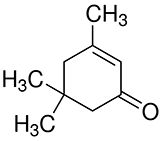A colorless liquid that sometimes has a slight amber color with a peppermint mint candy-like odor.
Structure:

Synonyms:
IPHO, Isoacetopherone, 3,5,5,Trimethyl-2- Cyclohexene-1-one
CAS#:
78-59-1
Formula:
C6H14
Family:
Ketone
Package Sizes
- Tote
- Drum
Regulatory Status:
non-HAPS, 100% VOC per SCAQMD
non-HAPS, 100% VOC per SCAQMD
Primary Applications:
Isophorone is used mainly as an intermediate for Industrial Polymers and Polycarbonates.
Industry Uses:
It is utilized at the distribution level to manufacture:
- Paints
- Coatings
- Enamels
- Metal Coatings
- Architectural Coatings
Safety Precautions:
Isophorone is is a combustible solvent. It must be handled with the proper Personal Protective Equipment. Please refer to the SDS for any questions or concerns.
Isophorone is is a combustible solvent. It must be handled with the proper Personal Protective Equipment. Please refer to the SDS for any questions or concerns.
Technical Documents:
Disclaimer
The A.G. Layne product information that is provided herein, including technical information, specifications, recommendations, literature, and other materials is strictly to aid an A.G. Layne customer in selecting a product for their use. The accuracy or completeness of this product information is not guaranteed and is subject to change without notice. Nor is any license granted or implied under any A.G. Layne or third party intellectual property rights. The customer is solely responsible for evaluating and selecting products to determine whether each product is fit for a particular purpose and suitable for customer’s use and method of application.
The A.G. Layne product information that is provided herein, including technical information, specifications, recommendations, literature, and other materials is strictly to aid an A.G. Layne customer in selecting a product for their use. The accuracy or completeness of this product information is not guaranteed and is subject to change without notice. Nor is any license granted or implied under any A.G. Layne or third party intellectual property rights. The customer is solely responsible for evaluating and selecting products to determine whether each product is fit for a particular purpose and suitable for customer’s use and method of application.

